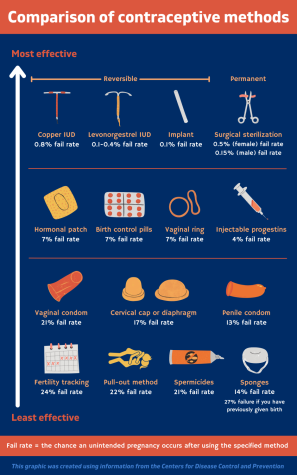The Pitt Prescription | Navigating birth control and Plan B following Valentine’s Day
The Pitt Prescription is a biweekly blog where student pharmacist and senior staff writer Elizabeth Donnelly provides tips on how to stay healthy in college. This edition was reviewed by Karen Pater, PharmD., CDCES, BCACP.
Shruti Talekar | Contributing Editor
The Pitt Prescription
February 18, 2022
Contraception — often referred to as birth control or the use of condoms — comes in many different forms. Since Valentine’s Day was last week, it’s important to discuss contraceptive options available to students.
There is a lot of stigma surrounding contraceptive methods, especially focused on young women’s use of emergency contraception such as Plan B. A study conducted in Kenya found that young or unmarried women are at the highest risk for stigma surrounding the use of contraceptives because of societal pressures, gender norms and religious beliefs. Further, it reports that society may view young women as “promiscuous” if they carry contraceptives like condoms or use birth control.
Although researchers conducted this study in Kenya, the findings are still relevant in the United States. Societal pressures and norms affect people everywhere. The United States and Kenya share many cultural aspects, including religion. Roughly 70% of the U.S. population is Christian while about 85% of Kenyans are Christian, which may have a large influence over attitudes toward contraception.
Reproductive and sexual health topics should not be seen as taboo, yet this is an ongoing issue. Discussing potential options and having open access to them without stigma is the best way to prevent unintended pregnancies. The Centers for Disease Control and Prevention estimates that around half of the total pregnancies each year are unintended, and are associated with worse health outcomes for the parent and infant. Because of this, it’s vital that people of child-bearing age understand the options available to them if they are having penetrative intercourse where sperm is involved.

Condoms – available over the counter
Latex penile condoms are the most common and readily available form of contraception that can be bought in many locations from the grocery store to gas stations. This method of contraception helps to prevent pregnancy as well as sexually transmitted infections. Other kinds of penile condoms, such as lambskin, may prevent pregnancy but are not effective in preventing STIs. Penile condoms should only be used once and may be used with water-based lubricant, but oil-based products should be avoided as they may weaken the latex and cause it to break. The typical use failure rate of penile condoms is about 13%, which means that these are only effective in preventing pregnancy roughly 87% of the time.
Latex vaginal condoms are another contraceptive option, and these may be inserted in the vagina up to eight hours before penetrative intercourse. This option also helps to prevent the transmission of STIs, but its typical use failure rate is about 21%.
Spermicides – available over the counter
Spermicides may come in gels, creams, foams, suppositories or other dosage forms. They are compounds that work to kill sperm to prevent them from getting to an egg. The user typically paces these products into the vagina no more than an hour before, and should be left for six to eight hours following intercourse. The typical use failure rate is about 21%.
Sponges are another product that can be used as a method of contraception. These sponges contain spermicide and are placed in the vagina prior to intercourse. They are effective for up to 24 hours, and should also not be removed for at least six hours following intercourse. Sponges have a different failure rate depending on if the user has had a baby before. The typical use failure rate for people who have never had a baby is 14%, but for those who have had a baby, it is 27%.
Barriers – prescription required
Diaphragms or cervical caps are able to be placed inside of the vagina to cover the cervix and prevent sperm from entering. Doctors recommend using spermicides with both diaphragms and cervical caps to increase efficacy of these products. They can be inserted up to six hours prior to intercourse and should be left in for at least six hours following, but no more than 24 hours post-intercourse. These barrier options require a prescription from a doctor because they are not one size fits all. Each person needs to be fitted properly in order for these options to be an effective contraceptive method. The typical use failure rate for barriers is 17%.
Hormonal Options – prescription required
There are several hormonal options available for contraception, the most common of which are combined oral contraceptives – also known as “the pill.” These options require more in-depth doctor’s visits and prescriptions with regular follow-ups. Other products include injections, patches, vaginal rings, and implants. Implants are the most effective, with a typical use failure rate of about 0.1%. Injections have a rate of 4% while the pills, ring and patches have a rate of 7%.
Intrauterine Devices – prescription required
IUDs may contain hormones or copper. These are small devices that are shaped like Ts that are placed in the uterus by a trained doctor. These prevent pregnancy but do not prevent STI transmission. Hormonal IUDs may last from three to six years while the copper IUD may last up to 10 years. The typical use failure rate of IUDs range from 0.1 to 0.8%.
Emergency Contraception – available OTC or with prescription
EC is not typically viewed as standard birth control. Its use should be reserved for situations where no other contraceptives were used during intercourse or if the method used failed, like a condom breaking. Copper IUDs may be used as emergency contraception if inserted within five days of intercourse, but the more common method is using emergency contraceptive pills, like Plan B.
Emergency contraceptive pills — sometimes referred to as “morning after pills” — may contain either levonorgestrel (Plan B) or ulipristal acetate (Ella). Other than the active ingredient, the main difference between these two options is that levonorgestrel can be bought over-the-counter without a prescription from a doctor. Any person of any age may purchase OTC levonorgestrel in the United States. Ulipristal acetate, on the other hand, is prescription-only, so a doctor’s visit is necessary to obtain this medication.
Plan B should be used within 72 hours of unprotected intercourse and it is most effective in individuals weighing 155 pounds or less. Ella can be used up to five days post intercourse and has a higher efficacy weight of 195 pounds or less. It is important to note that emergency contraceptives are not abortion pills. They do not induce any sort of abortion or stop fetal development if a fertilized egg is produced. EC solely works by delaying ovulation and preventing the fertilization of the egg in the first place.
There is a common belief that the more EC one takes, the less effective it is the next time. This is false. Emergency contraception, such as Plan B, does not lose its effectiveness after being taken multiple times, and using it multiple times should not cause any long-term side effects.
Cost and stigma are additional factors that people face when making decisions about contraception. EC, like Plan B, may be fairly expensive, costing about $50 at most pharmacies. There are generic options available for more reasonable prices, with more discreet ways to obtain it. For example, Amazon ships EC tablets for under $10, which is a huge cost savings for the buyer. Additionally, this allows for anonymity and less anxiety surrounding the stigma of being seen purchasing EC. The main concern with this method is the shipping time it takes to get to the user, since levonorgestrel should be used as soon as possible following intercourse.
Sexual activity is not shameful and it should not be frowned upon when done between two consenting adults. While preventative measures are the ideal choice for birth control, sometimes issues arise and using emergency contraception is necessary. Everyone should know the options available to them and feel comfortable discussing them with medical professionals. For any questions, especially about OTC contraceptives, you can always ask your local pharmacist for help.
Elizabeth writes primarily about self-care and pharmacological topics. For questions, comments or concerns, you can reach her at ead85@pitt.edu.



